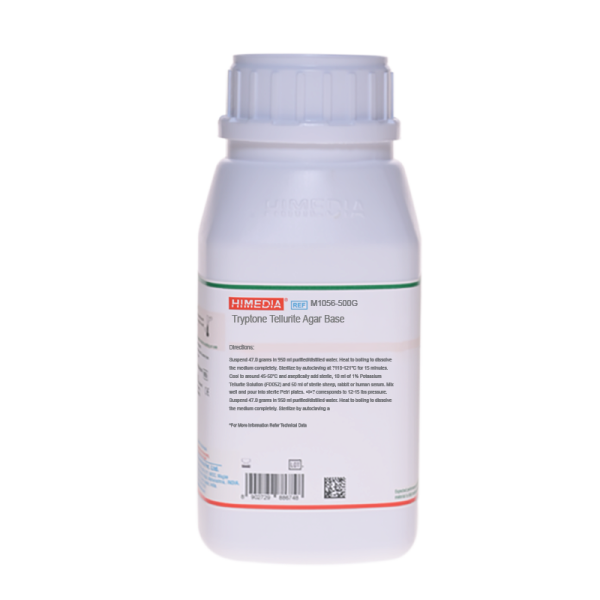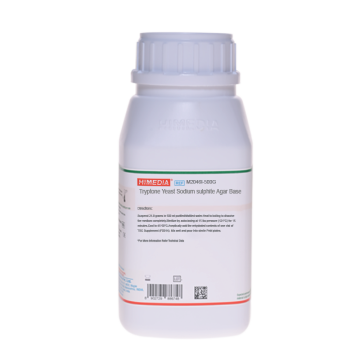 Your enquiry has been submitted
Your enquiry has been submitted
Tryptone Tellurite Agar Base
Intended Use
For selective isolation of pathogenic microorganisms from clinical specimens especially from nose, throat and vagina.
Composition
| Ingredients | g/L |
|---|---|
| Tryptone | 10.000 |
| Peptone | 10.000 |
| Sodium chloride | 5.000 |
| Dextrose (Glucose) | 2.000 |
| Agar | 20.000 |
Final pH (at 25°C): 7.5±0.2
Formula adjusted, standardized to suit performance parameters
Directions
Suspend 47.0 grams in 950 ml purified/distilled water. Heat to boiling to dissolve the medium completely. Sterilize by autoclaving at A118-121°C for 15 minutes. Cool to around 45-50°C and aseptically add sterile, 10 ml of PTe 1% Selective Supplement (1 ml per vial) (FD052) and 50 ml of sterile sheep, rabbit or human serum. Mix well and pour into sterile Petri plates. A corresponds to 12-15 lbs pressure.
Principle And Interpretation
Tryptone Tellurite Agar was prepared according to the specifications of the Maryland State, Department of Health as a medium for isolation of members of the genus Corynebacterium, particularly in the laboratory diagnosis of diphtheria (1). Pathogenic organisms like Corynebacterium, Streptococci are often responsible for infections in throat. These organisms are also more or less responsible for infecting the nasal cavity (2). Isolation of these organisms is important during diagnosis of fatal infections.
Tryptone and peptone present in the medium provide nitrogenous, carbonaceous compound and trace elements. Dextrose is an energy source. Sodium chloride maintains osmotic equilibrium. Potassium tellurite inhibits gram-negative and most gram-positive bacteria except Corynebacteria and some Streptococci (3). Serum provides additional growth factors for Corynebacterium species.
Type of specimen
Clinical samples- nose, throat and vagina samples
Specimen Collection and Handling
For clinical samples follow appropriate techniques for handling specimens as per established guidelines (3,4).
After use, contaminated materials must be sterilized by autoclaving before discarding.
Warning and Precautions
In Vitro diagnostic use only. For professional use only. Read the label before opening the container. Wear protective gloves/ protective clothing/eye protection/ face protection. Follow good microbiological lab practices while handling specimens and culture. Standard precautions as per established guidelines should be followed while handling clinical specimens. Safety guidelines may be referred in individual safety data sheets.
Limitations
- Further biochemical and serological tests must be carried out for complete identification.
- Individual organisms differ in their growth requirement and may show variable growth patterns on the medium.
Performance and Evaluation
Performance of the medium is expected when used as per the direction on the label within the expiry period when stored at recommended temperature.
Quality Control
Appearance: Cream to yellow homogeneous free flowing powder
Gelling
Firm, comparable with 2.0% Agar gel.
Colour and Clarity of prepared medium
Yellow coloured opalescent gel forms in Petri plates.
Reaction
Reaction of 4.7% aqueous solution at 25°C. pH: 7.5±0.2
pH
7.30-7.70
Cultural Response
Cultural characteristics observed after an incubation at 35-37°C with added PTe 1% Selective Supplement (1 ml per vial) (FD052) and sterile human serum for 24-48 hours.
| Organism | Inoculum (CFU) | Growth | Recovery | Colour of colony |
|---|---|---|---|---|
| Corynebacterium diphtheriae ATCC 11913 | 50-100 | luxuriant | >=50% | grey-black with dark centers |
| Escherichia coli ATCC 25922 (00013*) | >=104 | inhibited | 0% |
Key: (*) Corresponding WDCM numbers.
Storage and Shelf Life
Store between 10-30°C in a tightly closed container and the prepared medium at 2-8°C. Use before expiry date on the label. On opening, product should be properly stored dry, after capping the bottle in order to prevent lump formation due to the hygroscopic nature of the product. Improper storage of the product may lead to lump formation. Store in dry ventilated area protected from extremes of temperature and sources of ignition Seal the container tightly after use. Product performance is best if used within stated expiry period.
Disposal
User must ensure safe disposal by autoclaving and/or incineration of used or unusable preparations of this product. Follow established laboratory procedures in disposing of infectious materials and material that comes into contact with clinical sample must be decontaminated and disposed of in accordance with current laboratory techniques (3,4).
Reference
- Albers W. D., 1947, U.S. Naval Med. Bull., 47:33.
- Collee J. G., Fraser A. G., Marmion B. P., Simmons A. (Eds.), Mackie and McCartney, Practical Medical Microbiology, 1996, 14th Edition, Churchill Livingstone.
- Isenberg, H.D. Clinical Microbiology Procedures Handbook 2nd Edition.
- Jorgensen, J.H., Pfaller, M.A., Carroll, K.C., Funke, G., Landry, M.L., Richter, S.S and Warnock., D.W. (2015) Manual of Clinical Microbiology, 11th Edition. Vol. 1.
| Product Name | Tryptone Tellurite Agar Base |
|---|---|
| SKU | M1056 |
| Product Type | Regular |
| Physical Form | Powder |
| Origin | Animal |
| Packaging type | HDPE |
| References | 1.Albers W. D., 1947, U.S. Naval Med. Bull., 47:33.2.Collee J. G., Fraser A. G., Marmion B. P., Simmons A. (Eds.), Mackie and McCartney, Practical Medical Microbiology,1996, 14th Edition, Churchill Livingstone.3.MacFaddin J. F., 1985, Media for Isolation-Cultivation-Identification-Maintenance of Medical Bacteria, Vol. I, Williamsand Wilkins, Baltimore. |
| Customized Product Available | No |







